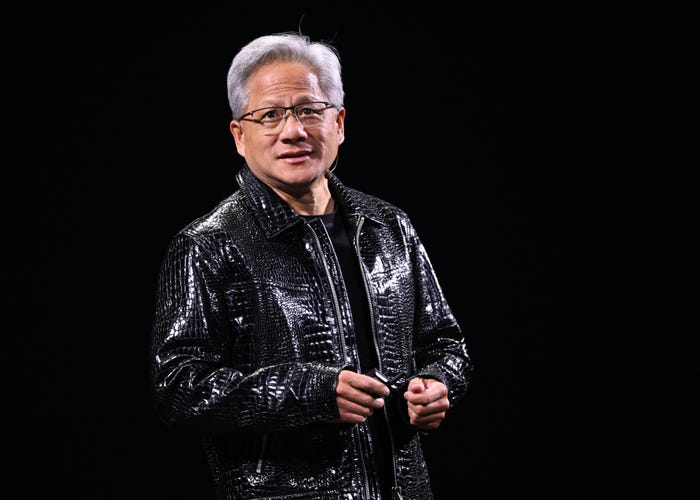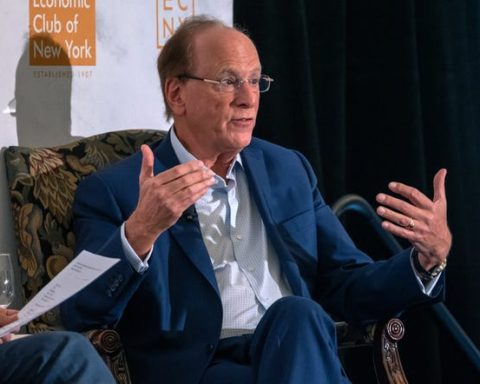Nvidia CEO Jensen Huang
At Nvidia, receiving a stern lecture from CEO Jensen Huang is considered a rite of passage. This sentiment has been echoed by Huang himself in various interviews, but now writer Stephen Witt can share his own firsthand experience. Witt is the author of The Thinking Machine: Jensen Huang, Nvidia, and the World’s Most Coveted Microchip, a book that chronicles Huang’s life and career, alongside Nvidia’s incredible journey from an underdog to a frontrunner in the AI revolution. Witt details a history filled with moments of heated discussions, as the company’s culture is notably demanding. Huang often prefers to dissect the team’s output during large meetings, allowing the entire group to learn collectively. Witt’s book explores not just the achievements of Nvidia’s team but also their thought processes — or lack thereof — regarding the broader implications of their inventions.
Stephen Witt’s The Thinking Machine displayed in a bookstore in Taipei, Taiwan. The book was first released in Asia and made its way to the US on Tuesday.
In the concluding scene of the book, which was previously released in Asia and hit US shelves on Tuesday, Witt recounted an interview with Huang that took place last year in a room filled with whiteboards outlining Nvidia’s past and future. After a grueling annual conference, Huang appeared visibly fatigued, responding to questions with short, measured replies. However, when Witt played a clip from 1964 featuring science fiction author Arthur C. Clarke speculating about machines one day surpassing human intelligence, Huang’s demeanor shifted entirely. Witt noted that it felt as if he had activated a “trip wire.” Huang was reluctant to engage in discussions about AI’s impact on jobs, continuing the interview, or collaborating on the book. Witt spoke with Business Insider about that day, shedding light on how Huang perceives himself in comparison to other tech giants like Elon Musk and Sam Altman. Nvidia chose not to comment on this.
This Q&A has been edited for clarity and length.
At the end of the book, Huang draws a comparison with Elon Musk and the fundamental differences between their outlooks. You prompted Huang to consider the future he’s contributing to, to which he remarked, “I feel like you’re interviewing Elon right now, and not me.” What did he mean by that?
I believe Jensen was highlighting that Elon is working from a science-fiction standpoint. Much of what Musk engages in starts with a futuristic vision, which he then reverse-engineers back to the technologies he needs today. Take Mars colonization — that’s a classic sci-fi ambition, and Musk systematically charts a path to make it a reality.
In contrast, Jensen’s primary goal is straightforward: he simply wants Nvidia to thrive. He responds to the present challenges and builds the company’s future from a foundation of practical logic and first principles. He isn’t inspired by science fiction — in fact, he has an aversion to it, which is why he reacted strongly to my questioning. He honestly admitted to never having read an Arthur C. Clarke book.
When interacting with figures like Musk and Altman, who are envisioning a grand AGI future, Jensen takes a grounded approach. He focuses on constructing the hardware that these visionary leaders need and watches where it leads. Unlike Sam Altman, who articulates compelling projections about the progression of AI in his writings, Jensen refrains from crafting such documents.
For instance, just last month, Musk streamed a company-wide meeting discussing a theory of boundless potential that could arise from AI.
Exactly. Jensen won’t engage in that sort of speculation. He prefers to contemplate the future logically, without diving into sci-fi narratives. Jensen is a multifaceted individual, and even now, I’m still trying to fully understand the reason behind that outburst.
It’s hard to believe, but I assure you it’s true: he dislikes public speaking, interviewing, and onstage presentations. Although he’s remarkably proficient at it, he genuinely detests the experiences and feels nervous whenever he’s required to do them. This stress manifests, especially during the atmosphere of the GTC.
Stephen Witt is the author of The Thinking Machine: Jensen Huang, Nvidia, and the World’s Most Coveted Microchip.
Earlier in the book, Huang casually expressed a wish to “die before the book comes out.” This remark led me to ponder who might succeed the 62-year-old Huang. Did you get any insights into a potential succession plan?
While he can’t lead the company indefinitely, he’s currently in great health and brimming with energy. For at least the next decade, it appears we’re all in for more Jensen. When I inquired about succession, they affirmed there’s no formal plan in place. Huang stated plainly, “I don’t have a successor.” In fact, his organizational hierarchy consists solely of himself at the top, with 60 individuals reporting directly to him. I mentioned in the book that he lacks a designated second-in-command. The board has raised this question, but no names were offered.
You write in the book about your gaming history and how you utilized Nvidia graphics cards until you consciously chose to stop due to concerns about addiction. Did Nvidia fade from your radar for 10 to 15 years during that time? What led you to write this book?
This is an intriguing story. I should have included this in the book. I purchased Nvidia stock in the early 2000s and sold it out of frustration when the price increased. My experience mirrored that of co-founder Curtis Priem; I sold my shares around 2005 or 2006, a decision that seemed wise at the time, especially as the stock tumbled afterward. I felt relieved after selling, as it plummeted by another 90% thereafter. Ultimately, I probably broke even or incurred a small loss. My background in finance taught me that selling underperforming stocks is often the best move for a portfolio due to tax benefits.
Thus, I was aware of the sunk-cost fallacy and thought I had made a solid trade. However, I paid no attention to the company for 17 years. It took the emergence of ChatGPT for me to notice Nvidia’s revival. I wondered, “What’s happening with Nvidia? Why is this gaming company performing so well?” I began to conduct research and discovered they had established a monopoly at the backend of AI.
At that point, I thought I’d approach Jensen and pitch him as a feature for The New Yorker. Initially, I assumed the story would be rather mundane, but I was astounded to uncover how captivating of a person Jensen truly is. I first figured that the stock surge must have stemmed from a new CEO shaking things up.
To my surprise, I found out that Jensen was still at the helm and, at that moment, was the longest-serving tech CEO within the S&P 500.
I thought, “Is it still the same guy? Still doing the same thing?” And Jensen proved to be an extraordinarily captivating character beyond my expectations.











